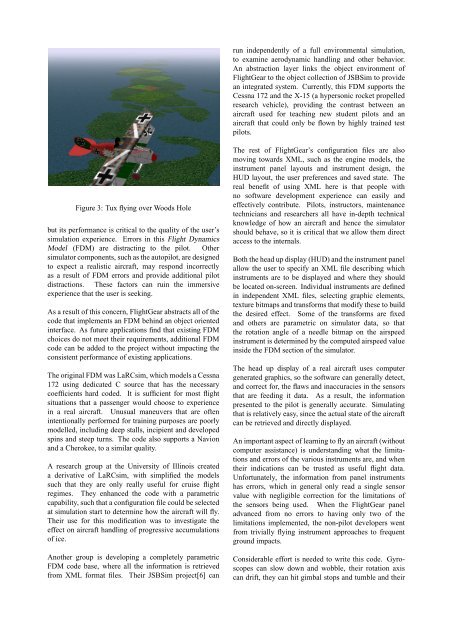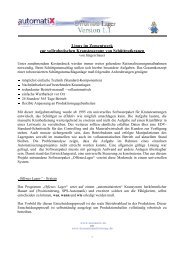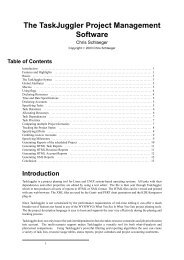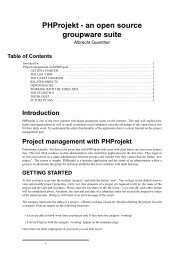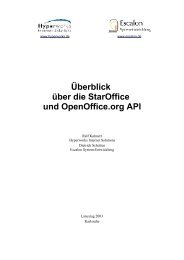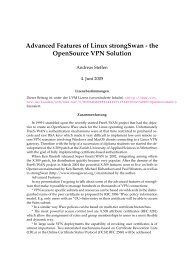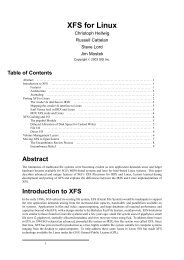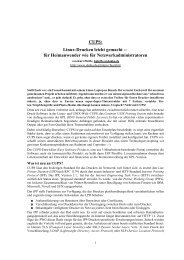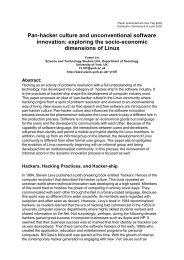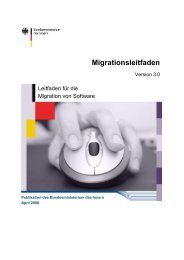The FlightGear Flight Simulator History, status and future
The FlightGear Flight Simulator History, status and future
The FlightGear Flight Simulator History, status and future
You also want an ePaper? Increase the reach of your titles
YUMPU automatically turns print PDFs into web optimized ePapers that Google loves.
Figure 3: Tux flying over Woods Hole<br />
but its performance is critical to the quality of the user’s<br />
simulation experience. Errors in this <strong>Flight</strong> Dynamics<br />
Model (FDM) are distracting to the pilot. Other<br />
simulator components, such as the autopilot, are designed<br />
to expect a realistic aircraft, may respond incorrectly<br />
as a result of FDM errors <strong>and</strong> provide additional pilot<br />
distractions. <strong>The</strong>se factors can ruin the immersive<br />
experience that the user is seeking.<br />
As a result of this concern, <strong><strong>Flight</strong>Gear</strong> abstracts all of the<br />
code that implements an FDM behind an object oriented<br />
interface. As <strong>future</strong> applications find that existing FDM<br />
choices do not meet their requirements, additional FDM<br />
code can be added to the project without impacting the<br />
consistent performance of existing applications.<br />
<strong>The</strong> original FDM was LaRCsim, which models a Cessna<br />
172 using dedicated C source that has the necessary<br />
coefficients hard coded. It is sufficient for most flight<br />
situations that a passenger would choose to experience<br />
in a real aircraft. Unusual maneuvers that are often<br />
intentionally performed for training purposes are poorly<br />
modelled, including deep stalls, incipient <strong>and</strong> developed<br />
spins <strong>and</strong> steep turns. <strong>The</strong> code also supports a Navion<br />
<strong>and</strong> a Cherokee, to a similar quality.<br />
A research group at the University of Illinois created<br />
a derivative of LaRCsim, with simplified the models<br />
such that they are only really useful for cruise flight<br />
regimes. <strong>The</strong>y enhanced the code with a parametric<br />
capability, such that a configuration file could be selected<br />
at simulation start to determine how the aircraft will fly.<br />
<strong>The</strong>ir use for this modification was to investigate the<br />
effect on aircraft h<strong>and</strong>ling of progressive accumulations<br />
of ice.<br />
Another group is developing a completely parametric<br />
FDM code base, where all the information is retrieved<br />
from XML format files. <strong>The</strong>ir JSBSim project[6] can<br />
run independently of a full environmental simulation,<br />
to examine aerodynamic h<strong>and</strong>ling <strong>and</strong> other behavior.<br />
An abstraction layer links the object environment of<br />
<strong><strong>Flight</strong>Gear</strong> to the object collection of JSBSim to provide<br />
an integrated system. Currently, this FDM supports the<br />
Cessna 172 <strong>and</strong> the X-15 (a hypersonic rocket propelled<br />
research vehicle), providing the contrast between an<br />
aircraft used for teaching new student pilots <strong>and</strong> an<br />
aircraft that could only be flown by highly trained test<br />
pilots.<br />
<strong>The</strong> rest of <strong><strong>Flight</strong>Gear</strong>’s configuration files are also<br />
moving towards XML, such as the engine models, the<br />
instrument panel layouts <strong>and</strong> instrument design, the<br />
HUD layout, the user preferences <strong>and</strong> saved state. <strong>The</strong><br />
real benefit of using XML here is that people with<br />
no software development experience can easily <strong>and</strong><br />
effectively contribute. Pilots, instructors, maintenance<br />
technicians <strong>and</strong> researchers all have in-depth technical<br />
knowledge of how an aircraft <strong>and</strong> hence the simulator<br />
should behave, so it is critical that we allow them direct<br />
access to the internals.<br />
Both the head up display (HUD) <strong>and</strong> the instrument panel<br />
allow the user to specify an XML file describing which<br />
instruments are to be displayed <strong>and</strong> where they should<br />
be located on-screen. Individual instruments are defined<br />
in independent XML files, selecting graphic elements,<br />
texture bitmaps <strong>and</strong> transforms that modify these to build<br />
the desired effect. Some of the transforms are fixed<br />
<strong>and</strong> others are parametric on simulator data, so that<br />
the rotation angle of a needle bitmap on the airspeed<br />
instrument is determined by the computed airspeed value<br />
inside the FDM section of the simulator.<br />
<strong>The</strong> head up display of a real aircraft uses computer<br />
generated graphics, so the software can generally detect,<br />
<strong>and</strong> correct for, the flaws <strong>and</strong> inaccuracies in the sensors<br />
that are feeding it data. As a result, the information<br />
presented to the pilot is generally accurate. Simulating<br />
that is relatively easy, since the actual state of the aircraft<br />
can be retrieved <strong>and</strong> directly displayed.<br />
An important aspect of learning to fly an aircraft (without<br />
computer assistance) is underst<strong>and</strong>ing what the limitations<br />
<strong>and</strong> errors of the various instruments are, <strong>and</strong> when<br />
their indications can be trusted as useful flight data.<br />
Unfortunately, the information from panel instruments<br />
has errors, which in general only read a single sensor<br />
value with negligible correction for the limitations of<br />
the sensors being used. When the <strong><strong>Flight</strong>Gear</strong> panel<br />
advanced from no errors to having only two of the<br />
limitations implemented, the non-pilot developers went<br />
from trivially flying instrument approaches to frequent<br />
ground impacts.<br />
Considerable effort is needed to write this code. Gyroscopes<br />
can slow down <strong>and</strong> wobble, their rotation axis<br />
can drift, they can hit gimbal stops <strong>and</strong> tumble <strong>and</strong> their


